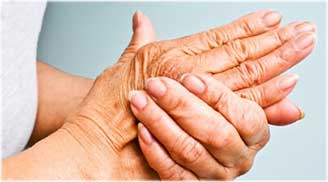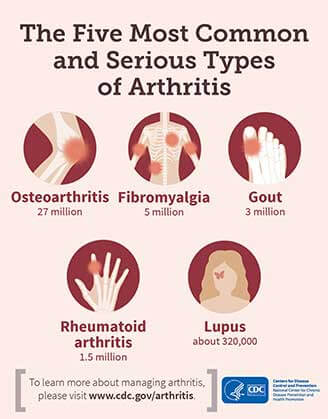Arthritis
What is it?
Arthritis is a condition in which the capsules that surround the various joints of the body become inflamed, painful, and can break down. Actually, hundreds of types of arthritis exist, but the two that are the most common are osteoarthritis and rheumatoid arthritis. Osteoarthritis is caused by the normal wear and tear on the joint. The joint material breaks down from overuse or increased pressure, and this causes pain. Rheumatoid arthritis is caused by the body’s immune system targeting the joint tissue. When the body targets the joint, it destroys it, and pain ensues. Both types of arthritis are treated by medications to reduce inflammation, such as steroids and non-steroidal anti-inflammatory drugs (NSAIDs), and sometimes surgical joint replacement.
Who gets it?
Arthritis can occur in many patient populations, but certain people are predisposed to the condition. Osteoarthritis is often seen in people who use their joints frequently. For instance, older adults are likely to have arthritis at some point merely because the joints have been in use for so long. Similarly, those who participate in sports often overuse their joints, and the pressure from this type of activity can lead to arthritis prematurely. Even those who carry extra pounds are at a greater risk for deterioration of the large joints due to arthritis. By contrast, anyone can be at risk for rheumatoid arthritis. Researchers are not sure what exactly causes the immune system to attack the joints, but it is felt that a genetic predisposition is likely. If rheumatoid arthritis runs in your family, you are more likely to experience it. In addition, it was found that women and those between the ages of 40 and 60 are more likely to present with symptoms of this type of arthritis, but it can occur at any age and to any sex. Finally, it has been shown that smoking can increase your risk for rheumatoid arthritis and quitting seems to mitigate that risk.

What kind of pain results?
The pain that results from both types of arthritis is similar. In osteoarthritis, you may experience pain upon movement, stiffness, and a grating feeling in the joint. In this type of arthritis, the pain tends to occur in the large joints, such as the knees, ankles, and hips. There are small joints between each vertebra from the neck to the lower back and these can develop arthritis as well. The joints will usually deteriorate symmetrically, so you will have pain in both knees or both shoulders. Redness and swelling are sometimes present. Rheumatoid arthritis produces the same stiff joint feeling, but many important differences are noted. Joints affected by this arthritis are usually very swollen, reddened, and painful to the touch. The pattern of the disease is different as well, and usually the symptoms occur on one side of the body. For instance, one hand may have swollen knuckles, and the other will have no symptoms at all. Finally, while osteoarthritis tends to occur in the larger joints, rheumatoid arthritis more commonly starts in the small joints of the hands and feet, and then it can eventually present in the larger joints.

Treatment
Typically, rheumatologists are consulted to diagnose and treat rheumatologic conditions such as rheumatoid arthritis, aggressive osteoarthritis, or other autoimmune conditions that cause joint pain. A rheumatologist can help with prescribing medications to control the immune system response, such as immunological medications, called “biologics” and steroids. Pain medicine providers treat pain from any type of arthritis using a variety of modalities. Medication management is usually the first line of treatment for any arthritis, and this can include over-the counter pain relievers such as acetaminophen and non-steroidal anti-inflammatory agents (NSAIDs), such as ibuprofen or naproxen. A referral to physical therapy will help keep the muscles around the arthritic joint strong and flexible, which supports the joint and minimizes pain that can result from stiff and tight muscles. Other treatments that can relieve arthritis pain include acupuncture, TENS units, massage and chiropractic care. If these conservative measures do not adequately address the pain, pain medicine physicians may prescribe stronger NSAIDs, antidepressants, and/ oral anti-seizure medications. Further, intra-articular joint injections are a possible treatment. These injections can be performed on the knees, hips, and shoulders to help decrease the inflammation in the joint. Hyaluronidase gels, can be injected into joints and provide relief by acting as a cushion. When medications and injections are not sufficient to control pain, a referral to an orthopedic surgeon may be necessary to surgically replace arthritic joints.



